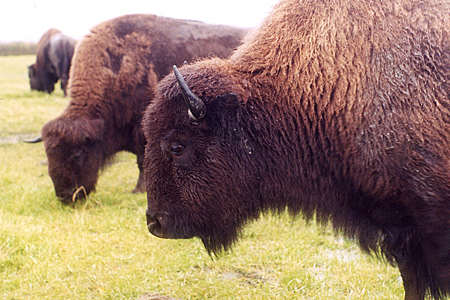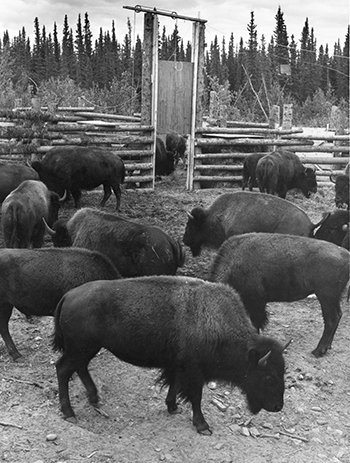Alaska Fish & Wildlife News
October 2024
Plains bison and wood bison

Wood bison are the largest native land mammal in North America. A big male can weigh a ton and stand taller at the shoulder than a grown man. They are noticeably larger than plains bison, their close relatives.
Plains bison and wood bison evolved from steppe bison, an ice-age bison (famous from cave paintings) found across Europe, Asia and North America that went extinct a few thousand years ago. Plains bison flourished in the south and wood bison adapted to more northern climate and environment. Both are subspecies of American bison.
“They are very similar - they are the same species, and they can interbreed,” said Biologist Tom Seaton. That said, they look noticeably different. “They are one of the few subspecies you can recognize 100 yards away – different hair pattern, the hump, the head, the curvature of the horns, what they eat and their vocalizations.”

A wood bison's hump is taller and has its highest point forward of the front legs. The wood bison has woolly hair along its ribs, where plains bison have shorter hair. The hair of the wood bison's beard, throat latch, ventral neck mane, chaps, and penis tuft are less developed than that of plains bison. Wood bison vocalizations are different vocalizations from those of plains bison, and the wood bison's social interactions during the rut tend to be less violent than plains bison.
“Plains tend to roar in the rut,” Seaton said. “Wood don’t roar during rut. They have different behavior. Wood bison are probably always in smaller groups, and plains bison might’ve had hundreds in a group during the rut.”

All of these differences are evidence of the wood bison's adaptation to its northern environment: pockets of grassy meadow habitat within the sea of boreal forest, where temperatures can be quite cold and snow can be deep for extended periods.
“Both species are highly adaptable,” Seaton said. “Plains bison were brought here almost 100 years ago, and they’re doing quite well because they’re highly adaptable. Both species can adapt well to different habitats.”
Subscribe to be notified about new issues
Receive a monthly notice about new issues and articles.
